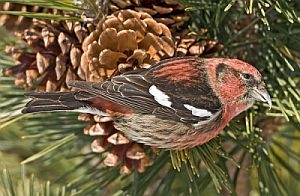 (Host) Large numbers of Arctic birds have made their way to Northeastern states in the past few months.
(Host) Large numbers of Arctic birds have made their way to Northeastern states in the past few months.
Although it’s not unusual for these birds to come south in the winter looking for food, ornithologists say it’s rare to see so many species.
As part of a collaboration with Northeast public radio stations, WXXI’s Bud Lowell reports.
(Sounds of water and wind)
(Lowell) Bird watchers, like June Summers of the Genesee Valley Audubon Society in Rochester, New York will go out of their way to get a glimpse of some uncommon species. Standing on the edge of Lake Ontario, she points out about 20 black and white ducks paddling in the icy chop…..
(Summers) "This little duck right up here…in white and black…these are long tailed ducks. They’re a more arctic species. They’re not associated with the boreal forest, but they’re an absolutely striking duck…"
(Lowell) Long tailed ducks usually breed along sea coasts and large mountain lakes in Alaska, northern Canada, and Russia. This winter, they’ve come further south and west than usual. And they’re not the only species that have come south this winter.
The arctic snowy owl has been seen in unusual numbers across the Northeast — and even as far south as Virginia. Trudging through fresh snow, Summers says finches like pine siskins and white winged crossbills that feed on pine cones in the far northern forests have come south, too…
(Summers) "We don’t see this many of ’em normally. We see a few each year…but the number of flocks in the Rochester area and in New York is enormous…all sorts of sightings of them everywhere. It must be a pretty tough winter up north. I personally thought is was a pretty tough winter here."
(Lowell) Milan Bull of the Connecticut Audubon Society says these birds — such as the winter finches — are grocery shopping.
(Bull) "The food sources for all these birds are cyclical, and when the cycle is down…when pine cones are down in the boreal forests…the finches move further south. The same is true for snowy owls, except their main food is lemmings."
(Lowell) When birds leave their home turf looking for food, scientists call it an "eruptive migration."
Some people may think it has something to do with climate change, but Wes Hochaka of the Cornell University Ornithology Laboratory says this has been happening every couple of years since the last ice age.
(Hochaka) "These are birds that for generations have faced fluctuating food supplies, and their solution is to stay as far north as possible, but if you have to, move south…sometimes very far south."
(Lowell) But Hochaka says conservationists are tracking of these eruptions — because if northern species start showing up more and more frequently every winter instead of every few winters, it might indicate climate change at work.
 Another rare bird sighting has raised additional questions.
Another rare bird sighting has raised additional questions.
This year, bird watchers saw two adult ivory gulls on the Massachusetts coast, and one was sighted last winter in Rhode Island.
Wayne Peterson is director of the important bird area program for the Massachusetts Audubon Society. He says this is very rare.
(Peterson) "I’ve been birding since I was a child…only 3 or 4 Ivory Gulls have been seen in Massachusetts since the 60’s — the last one in 1985."
(Lowell) And Peterson notes the Ivory Gulls have shown up in the Northeast at a time when their numbers are declining in the arctic. Wildlife experts are trying to figure out what their arrival here this winter means.
For VPR News, I’m Bud Lowell
(Host) Northeast Environmental coverage is part of NPR’s Local News Initiative. The reporting is made possible, in part, by a grant from United Technologies.